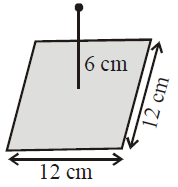
Solution:
To calculate the electric flux through the square, we use Gauss's law and symmetry principles.
The total flux from a point charge \(q = +20 \, \mu\text{C}\) is:
\[
\Phi_{\text{total}} = \frac{q}{\epsilon_0}
\]
Here:
- \(q = 20 \times 10^{-6} \, \text{C}\),
- \(\epsilon_0 = 8.854 \times 10^{-12} \, \text{C}^2/\text{N·m}^2\).
The square is part of an imaginary cube with the charge at its center. The flux through one face of the cube (the square in question) is:
\[
\Phi_{\text{square}} = \frac{\Phi_{\text{total}}}{6} = \frac{q}{6\epsilon_0}
\]
Substitute the values:
\[
\Phi_{\text{square}} = \frac{20 \times 10^{-6}}{6 \times 8.854 \times 10^{-12}}
\]
Simplify:
\[
\Phi_{\text{square}} = 3.77 \times 10^5 \, \text{N·m}^2/\text{C}
\]
Thus, the flux through the square is approximately:
\[
{3.8 \times 10^5 \, \text{N·m}^2/\text{C}}
\]
Leave a Reply